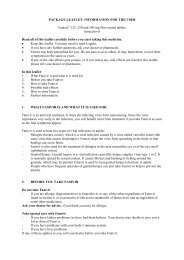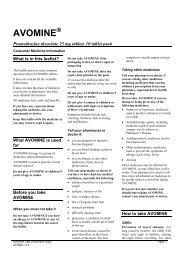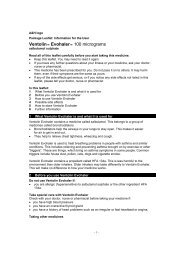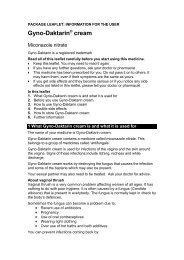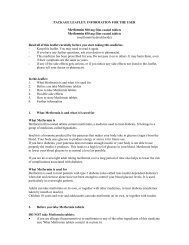package leaflet: information for the user - HealthExpress.co.uk
package leaflet: information for the user - HealthExpress.co.uk
package leaflet: information for the user - HealthExpress.co.uk
You also want an ePaper? Increase the reach of your titles
YUMPU automatically turns print PDFs into web optimized ePapers that Google loves.
• On Day 15 (Week 3), take off <strong>the</strong> used patch<br />
• Put on ano<strong>the</strong>r new one.<br />
This makes a total of three weeks with <strong>the</strong> patches.<br />
To help stop irritation, do not put <strong>the</strong> new patch on exactly <strong>the</strong><br />
same area of your skin as your last patch.<br />
Do not wear a patch on Week 4 (Day 22 through Day 28).<br />
• You should have your period during this time<br />
• During this week you are protected from getting pregnant only<br />
if you start your next patch on time.<br />
For your next four week cycle<br />
• Put on a new patch on your normal “Patch Change Day”, <strong>the</strong><br />
day after Day 28<br />
• Do this no matter when your period begins or ends.<br />
If you want to change your “Patch Change Day” to a different day of <strong>the</strong> week talk to your<br />
doctor.<br />
Everyday activities while using <strong>the</strong> patches<br />
• Normal activities such as having a bath or shower, using a sauna and exercising should<br />
not affect how well <strong>the</strong> patch works<br />
• The patch is designed to stay in place during <strong>the</strong>se types of activities<br />
• However, you should check that <strong>the</strong> patch has not fallen off after doing <strong>the</strong>se activities.<br />
If you need to place <strong>the</strong> patch on a new area on your body on a day o<strong>the</strong>r than your<br />
“Patch Change Day”<br />
If <strong>the</strong> patch causes irritation or you be<strong>co</strong>me un<strong>co</strong>m<strong>for</strong>table wearing it:<br />
• You can take it off and replace it with a new patch in a different place on your body<br />
until your next “Patch Change Day”<br />
• You may only use one patch at a time.<br />
If you have trouble remembering to change your patch<br />
• Talk to your doctor or ano<strong>the</strong>r healthcare professional at <strong>the</strong> clinic. He/she may be able<br />
to make patch changing easier <strong>for</strong> you. He/she may also talk about whe<strong>the</strong>r you need to<br />
use ano<strong>the</strong>r method of <strong>co</strong>ntraception.<br />
If your patch be<strong>co</strong>mes loose, lifts at <strong>the</strong> edges or falls off<br />
For less than one day (up to 24 hours):<br />
• Try to put it on again or put on a new patch immediately<br />
• Back-up <strong>co</strong>ntraception is not needed<br />
• Your “Patch Change Day” should remain <strong>the</strong> same<br />
• Do not try to put a patch back on if:<br />
- it is no longer sticky<br />
- it has be<strong>co</strong>me stuck to itself or ano<strong>the</strong>r surface<br />
- it has o<strong>the</strong>r material stuck to it<br />
- it is <strong>the</strong> se<strong>co</strong>nd time it has be<strong>co</strong>me loose or has fallen off



